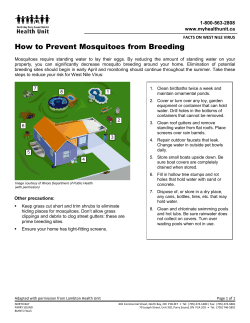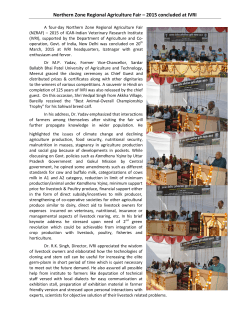
T he hidden side of the truth
Livestock: the scapegoats of global warming!! e den d i h side of the tr h ut Th Livestock and the environment The FAO report entitled “Livestock’s long shadow” on climate change received considerable media coverage. However, after analysis, this report can be seen to be partial and difficult to transpose to Europe. Aware of its omissions, exaggerations and errors, the FAO drew up a new and much more detailed report… but which unfortunately received scant coverage in the media! WHY ARE THE COMPARISONS THAT INUNDATE THE MEDIA FALSE ? • 1 kg of beef = 16,000 litres of water1 ?? No, this figure is obtained by means of a calculation that in particular includes the amount of rainfall on fodder areas and pasture land. Such being the case, in all scenarios and regardless of the land’s use, this water would have fallen on these expanses. On a human scale, this would be tantamount to including the rain which falls on our roof, our garden, etc., in our “water footprint”. And yet, who can seriously claim that this water has been stolen from another use? At the Belgian level, statistics from EUROSTAT2 show that agriculture accounts for 1% of water sampling. • 1 kg of beef = 7 kg of cereal crops3??? Since it has been proved that pigs and chickens consume 75% of cereals and grain used for animal feed , how is it possible to criticize ruminants on their so-called competition with human food? Has it been forgotten that ruminants can (and more importantly must) digest cellulose from fodder and that they supplement the agri-feed and bio-fuel industries by using their waste (pulp, grains, bran, etc.)? • 1 kg of beef = 155 miles in a car5 ??? The FAO has admitted this fact itself: this comparison is simplistic and inaccurate! And when the FAO claims that livestock breeding produces more greenhouse gas emissions than transports6, this does not concern developed countries. For developing countries, this can be explained by the fact that the industrial and transport sectors are virtually insignificant. Consequently, emissions are necessarily lower than the main activity which is livestock breeding. Is livestock breeding really more harmful than transport???? WHAT THE FAO DIDN’T TAKE INTO ACCOUNT : • The FAO attributes 35% of greenhouse gas emissions from livestock breeding to deforestation of rain forsts6, considering that all deforestation is performed to provide land intended for animal fodder crops. However, the driving force behind deforestation in Indonesia is the growth of trees to produce palm oil, the demand for which is constantly growing to meet requirements for human food (in which this oil is extremely harmful for human health), cosmetics and bio-fuels7. A report by the international NGO “Friends of the Earth” shows that between 1985 and 2000, the development of plantations for palm oil was responsible for 87% of deforestation Malaysia. Another example is that of Brazil, which, over 2.7 million hectares of freshly deforested land, is now growing sugar cane for the production of bio-ethanol. • When calculating emissions, the FAO exclusively considered livestock breeding as a source of greenhouse gas emissions, forgetting that the fodder areas directly dependent on livestock breeding are carbon sinks. This omission has also been acknowledged by the organization and corrections which are currently being examined. Indeed, it is aberrant to not consider the assets that pasture land offers, whereas, for obvious ecological reasons, European regulations stipulate that it is compulsory to permanently maintain, at national level, a proportion of this pasture land each year. POINTS MISSED BY THE CRITICS OF LIVESTOCK BREEDING • Nobody has examined the issue of knowing what other human activity would replace the resources “released” by the livestock breeding sector, if it were to disappear or decline. Even more importantly, we know that all human activities, apart from forestry and farming, cannot offset (even partially) their greenhouse gas emissions; they are carbon sources in absolute terms. It is therefore certain that the activities that would replace livestock breeding would have a greater impact on climate change. It is thus completely unrealistic to believe that if livestock breeding disappeared, the 18% of anthropogenic emissions with which it is improperly associated to would be neutralized8. Are you ready to give up this....................for this..........................or this? • Livestock breeding is not only a source of milk, meat and eggs. It also produces wool, leather, energy (labour, transport), etc. What would be the environmental impact of the substitutes of such products (wool replaced by microfibers, leather by vinyl, manure by chemical fertilizers, etc.)8. ULTIMATELY, IS IT LEGITIMATE TO CHOOSE A VEGETARIAN DIET FOR ENVIRONMENTAL REASONS ? • Not according to the University of Cranfield (UK)9 which was commissioned by the WWF to study the question. Their findings state that becoming vegetarian and replacing meat with high-protein value substitutes such as tofu causes more harm to the environment. The use of arable land (in particular outside the EU) would be increased, accentuating deforestation. • Not according to the Swiss Federal Institute of Technology Zurich (ETH)10 which demonstrates that the energy saving advantages of a diet without meat but including dairy products and eggs is almost nil given that, on the one hand, crop production for feed given to dairy cows and egg producing hens is maintained, and on the other hand, the amounts of cereals, pulses, fruits and vegetables are higher to offset the absence of meat for its energy and protein input. Furthermore, since the production of milk or eggs and meat is naturally connected, the ovolacto-vegetarian diet is ecologically incoherent. ULTIMATELY, IS IT LEGITIMATE TO CHOOSE A VEGETARIAN DIET FOR ENVIRONMENTAL REASONS ? • Not according to the Stockholm Royal Institute of Technology11 which highlights that more importantly than the composition of what we eat, its origin and production methods are determining factors for energy savings in food production. Since food that is rich in crop sources, or even vegetarian, can be just as intensive in fossil fuels as traditional food products, the authors argue that the discussion should not be reduced to a match between animal products and crop products, but that the origin of the food and its production methods are taken into consideration. Where your beef comes from : You choose!!! Where your tomatoes and strawberries come from : Hoekstra (2007): Water footprints of nations: water use by people as a function of their consumption pattern. Water Ressour Manage 21:35-48 2 Pacific Institude (2006):Freshwater withdrawal by country and sector .http://www.worldwater.org/data20082009/Table2. pdf 3 http://www.la-viande.info/vegetarisme/raison_planete_vegetarien.htm 4 Galloway et al (2007). International trade in meat : the tip of the pork shop. Ambio 36, 622-629. 5 http://www.newscientist.com/article/mg19526134.500 6 FAO. Steinfeld et al (2006) Livestock’s Long Shadow : http://www.fao.org/docrep/010/a0701e/a0701e00.HTM 7 Adriaens (2006). La planète menacée par la famine? http://www.etopia.be/IMG/pdf/Adriaens.pdf 8 Mitloenher et al (2009). Clearing the air : livestock’s contribution to climate change. Advances in Agronomy, 103. 9 Audsley, E.et al (2009). How low can we go? An assessment of greenhouse gas emissions from the UK food system and the scope to reduce them by 2050. FCRN-WWF-UK. 10 Faist et al (2000), Ressourceneffizienz in der Aktivitat Ernahren , thèse ETH nr13884, Zurich. 11 Wallén et al (2004). Does the Swedish consumer’s choice of food influence greehouse gas emission? Environmental Science & Policy 7, 525-535. 1 Written by Herd-Book BBB ASBL with the support of APAQ-W
© Copyright 2025















